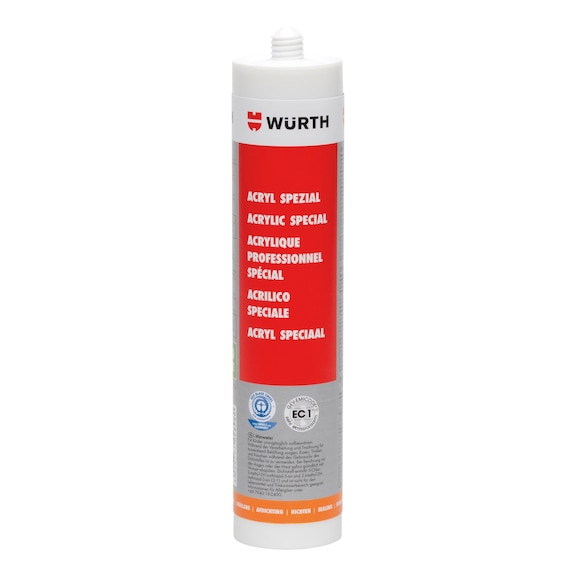For detailed information, other images and documents, please select individual articles from the following table.
Acrylic Special
Special acrylic sealant that minimises development of cracks and discolouration of emulsion paints at the joint
Register now and access more than 125,000 products


Variants
Register now and access more than 125,000 products
Call customer service: 014/44.55.66
Prices for customers after login
- After only a few hours, it can be plastered and painted over with high-quality emulsion paints
- Reduces the risk of development of cracks and of discolouration of the applied emulsion paints
- Resistant to ageing, weathering and UV
- Plastoelastic
- Free from silicone, solvents and phthalates
Our Acrylic Special sealant carries the "Blauer Engel" eco-label.
Not suitable for use in building construction joints in accordance with DIN 18540. Due to the wide variety of paint and lacquer formulas available, we recommend that you always carry out preliminary testing in order to rule out any interactions. Caution: Sealant joints that have been fully painted over tend to crack when movement occurs in the joint, as the applied paint is generally less elastic than the sealant. The setting speed is dependent on the application temperature, the weather and the surface moisture. The speed is greatly delayed in cold, damp weather. Discolouration may occur in wood containing tannic acid. For vertical joints, please observe the run-off behaviour of the sealant. May cause corrosion on metals such as steel, copper and zinc-plated surfaces.
4Acrylic sealants are very unstable in terms of water absorption and release. Since the diffusion behaviour also changes as a result of the differences in water adsorption in the material, no constant measured values can be recorded for the water vapour diffusion equivalent resistance coefficient (μ) or the diffusion equivalent layer thickness (Sd) on this material in accordance with DIN EN 12572.
The value of 5000 is the average value obtained through testing.
Special acrylic sealant for use between walls and ceilings, and on interior and exterior door frames.
Adhesion surfaces must be clean, dry and firm. Priming improves adhesion to porous and highly absorbent substrates. Please observe the "General Notes on Application for Sealants" overview sheet. For more information, please refer to the technical data sheet.
Select RAL-colour code
!! NOTE: On-screen visualisation of the colour differs from real colour shade!!



